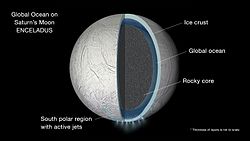
Astrobiology is a scientific field within the life and environmental sciences that studies the origins, early evolution, distribution, and future of life in the universe through investigating its deterministic conditions and contingent events. As a discipline, astrobiology is founded on the premise that life may exist beyond Earth.

Europa, or Jupiter II, is the smallest of the four Galilean moons orbiting Jupiter, and the sixth-closest to the planet of all the 92 known moons of Jupiter. It is also the sixth-largest moon in the Solar System. Europa was discovered in 1610 by Galileo Galilei and was named after Europa, the Phoenician mother of King Minos of Crete and lover of Zeus.

Enceladus is the sixth-largest moon of Saturn. It is about 500 kilometers in diameter, about a tenth of that of Saturn's largest moon, Titan. Enceladus is mostly covered by fresh, clean ice, making it one of the most reflective bodies of the Solar System. Consequently, its surface temperature at noon only reaches −198 °C, far colder than a light-absorbing body would be. Despite its small size, Enceladus has a wide range of surface features, ranging from old, heavily cratered regions to young, tectonically deformed terrain.
A biosignature is any substance – such as an element, isotope, or molecule – or phenomenon that provides scientific evidence of past or present life. Measurable attributes of life include its complex physical or chemical structures and its use of free energy and the production of biomass and wastes. A biosignature can provide evidence for living organisms outside the Earth and can be directly or indirectly detected by searching for their unique byproducts.
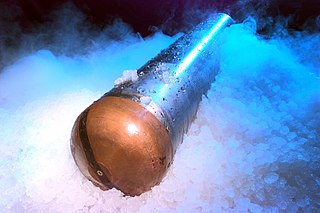
A cryobot or Philberth-probe is a robot that can penetrate water ice. A cryobot uses heat to melt the ice, and gravity to sink downward.
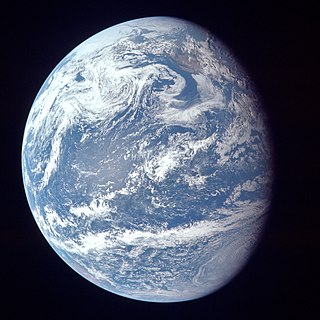
An ocean world, ocean planet, panthalassic planet, maritime world, water world or aquaplanet, is a type of planet that contains a substantial amount of water in form of oceans, either beneath the surface, as subsurface oceans, or on the surface with a hydrosphere, potentially submerging all dry land. The term ocean world is also used sometimes for astronomical bodies with an ocean composed of a different fluid or thalassogen, such as lava, ammonia or hydrocarbons like on Titan's surface.
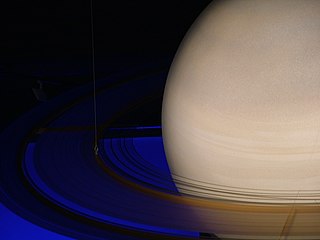
The exploration of Saturn has been solely performed by crewless probes. Three missions were flybys, which formed an extended foundation of knowledge about the system. The Cassini–Huygens spacecraft, launched in 1997, was in orbit from 2004 to 2017.
Extraterrestrial liquid water is water in its liquid state that naturally occurs outside Earth. It is a subject of wide interest because it is recognized as one of the key prerequisites for life as we know it and thus surmised as essential for extraterrestrial life.

The habitability of natural satellites is a measure of their potential to sustain life in favorable circumstances. Habitable environments do not necessarily harbor life. Natural satellite habitability is a new area that is significant to astrobiology for various reasons, the most important of which being that natural satellites are expected to outnumber planets by a large margin, and it is projected that habitability parameters will be comparable to those of planets. There are, nevertheless, significant environmental variables that affect moons as prospective alien life locations. The strongest candidates for natural satellite habitability are currently icy satellites such as those of Jupiter and Saturn—Europa and Enceladus respectively, although if life exists in either place, it would probably be confined to subsurface habitats. Historically, life on Earth was thought to be strictly a surface phenomenon, but recent studies have shown that up to half of Earth's biomass could live below the surface. Europa and Enceladus exist outside the circumstellar habitable zone which has historically defined the limits of life within the Solar System as the zone in which water can exist as liquid at the surface. In the Solar System's habitable zone, there are only three natural satellites—the Moon, and Mars's moons Phobos and Deimos —none of which sustain an atmosphere or water in liquid form. Tidal forces are likely to play as significant a role providing heat as stellar radiation in the potential habitability of natural satellites.
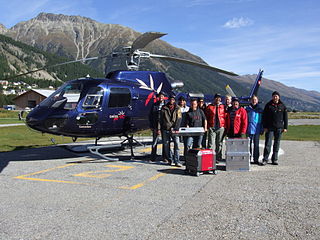
IceMole is an autonomous ice research probe, incorporating a new type of ice-melting tip for the exploration of polar regions, glaciers, ice sheets, and extraterrestrial regions, developed by a team from the FH Aachen, a Fachhochschule in Aachen, Germany. The advantage over previous probes is that the IceMole can change its direction and can be recovered after being used. A driving ice screw allows the probe to drill through soil layers and other contaminations in the ice.
Planetary oceanography also called astro-oceanography or exo-oceanography is the study of oceans on planets and moons other than Earth. Unlike other planetary sciences like astrobiology, astrochemistry and planetary geology, it only began after the discovery of underground oceans in Saturn's moon Titan and Jupiter's moon Europa. This field remains speculative until further missions reach the oceans beneath the rock or ice layer of the moons. There are many theories about oceans or even ocean worlds of celestial bodies in the Solar System, from oceans made of diamond in Neptune to a gigantic ocean of liquid hydrogen that may exist underneath Jupiter's surface.

Enceladus Life Finder (ELF) is a proposed astrobiology mission concept for a NASA spacecraft intended to assess the habitability of the internal aquatic ocean of Enceladus, which is Saturn's sixth-largest moon and seemingly similar in chemical makeup to comets. The spaceprobe would orbit Saturn and fly through Enceladus's geyser-like plumes multiple times. It would be powered by energy supplied from solar panels on the spacecraft.
Journey to Enceladus and Titan (JET) is an astrobiology mission concept to assess the habitability potential of Enceladus and Titan, moons of Saturn.
Life Investigation For Enceladus (LIFE) was a proposed astrobiology mission concept that would capture icy particles from Saturn's moon Enceladus and return them to Earth, where they could be studied in detail for signs of life such as biomolecules.
THEO is a feasibility study for a New Frontiers class orbiter mission to Enceladus that would directly sample its south pole water plumes in order to study its internal habitability and to search for biosignatures. Specifically, it would take advantage of the direct sampling opportunities of a subsurface ocean.
Mars habitability analogue environments on Earth are environments that share potentially relevant astrobiological conditions with Mars. These include sites that are analogues of potential subsurface habitats, and deep subsurface habitats.

Explorer of Enceladus and Titan (E2T) is a space mission concept that would investigate the evolution and habitability of the Saturnian satellites Enceladus and Titan and is proposed by the European Space Agency in collaboration with NASA.

The Ocean Worlds Exploration Program (OWEP) is a NASA program to explore ocean worlds in the outer Solar System that could possess subsurface oceans to assess their habitability and to seek biosignatures of simple extraterrestrial life.
The Enceladus Icy Jet Analyzer (ENIJA) is a time-of-flight mass spectrometer developed to search for prebiotic molecules like amino acids and biosignatures in the plumes of Saturn's moon Enceladus.

SPINDLE is a 2-stage autonomous vehicle system consisting of a robotic ice-penetrating carrier vehicle (cryobot) and an autonomous submersible HAUV . The cryobot is designed to descend through an ice body into a sub-surface ocean and deploy the HAUV submersible to conduct long range reconnaissance, life search, and sample collection. The HAUV submersible will return to, and auto-dock with, the cryobot at the conclusion of the mission for subsequent data uplink and sample return to the surface.
